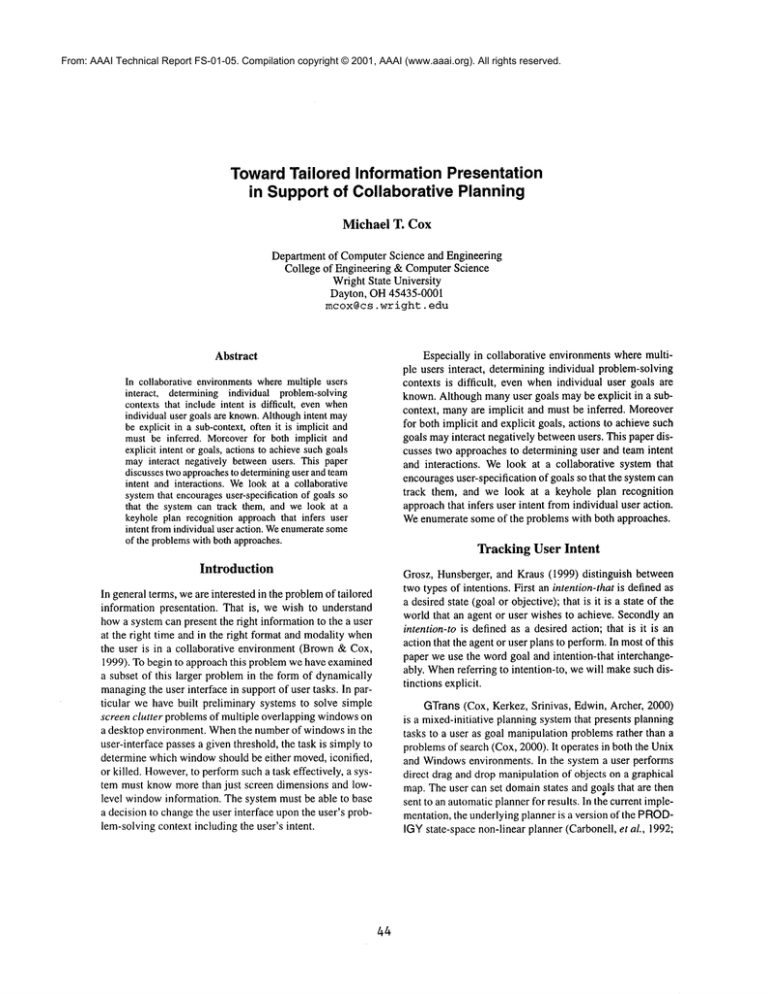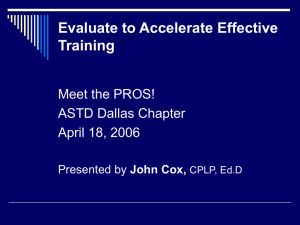
From: AAAI Technical Report FS-01-05. Compilation copyright © 2001, AAAI (www.aaai.org). All rights reserved.
TowardTailored Information Presentation
in Supportof Collaborative Planning
Michael
T. Cox
Department of ComputerScience and Engineering
College of Engineering & ComputerScience
Wright State University
Dayton, OH45435-0001
mcox@cs, wright, edu
Especially in collaborative environmentswhere multiple users interact, determining individual problem-solving
contexts is difficult, even whenindividual user goals are
known.Althoughmanyuser goals maybe explicit in a subcontext, manyare implicit and must be inferred. Moreover
for both implicit and explicit goals, actions to achieve such
goals mayinteract negatively betweenusers. This paper discusses two approaches to determining user and team intent
and interactions. Welook at a collaborative system that
encouragesuser-specification of goals so that the systemcan
track them, and we look at a keyhole plan recognition
approachthat infers user intent from individual user action.
Weenumerate someof the problems with both approaches.
Abstract
In collaborative environmentswheremultiple users
interact, determining individual problem-solving
contextsthat include intent is difficult, evenwhen
individual user goals are known.Althoughintent may
be explicit in a sub-context,often it is implicit and
must be inferred. Moreoverfor both implicit and
explicit intent or goals, actions to achievesuchgoals
mayinteract negatively betweenusers. This paper
discussestwoapproachesto determininguser andteam
intent and interactions. Welook at a collaborative
systemthat encouragesuser-specificationof goals so
that the system can track them, and we look at a
keyholeplan recognition approachthat infers user
intent fromindividualuser action. Weenumeratesome
of the problemswith both approaches.
Tracking User Intent
Introduction
In general terms, weare interested in the problemof tailored
information presentation. That is, we wish to understand
howa systemcan present the right information to the a user
at the right time and in the right format and modality when
the user is in a collaborative environment (Brown&Cox,
1999). To begin to approach this problem we have examined
a subset of this larger problemin the form of dynamically
managingthe user interface in support of user tasks. In particular we have built preliminary systems to solve simple
screen clutter problemsof multiple overlapping windowson
a desktop environment. Whenthe numberof windowsin the
user-interface passes a given threshold, the task is simplyto
determine which windowshould be either moved,iconified,
or killed. However,to performsuch a task effectively, a system must knowmore than just screen dimensions and lowlevel windowinformation. The system must be able to base
a decision to changethe user interface uponthe user’s problem-solvingcontext including the user’s intent.
44
Grosz, Hunsberger, and Kraus (1999) distinguish between
two types of intentions. First an intention-that is defined as
a desiredstate (goal or objective); that is it is a state of the
world that an agent or user wishes to achieve. Secondlyan
intention-to is defined as a desired action; that is it is an
action that the agent or user plans to perform.In mostof this
paper we use the wordgoal and intention-that interchangeably. Whenreferring to intention-to, we will makesuch distinctions explicit.
GTrans(Cox, Kerkez, Srinivas, Edwin, Archer, 2000)
is a mixed-initiative planning systemthat presents planning
tasks to a user as goal manipulationproblemsrather than a
problemsof search (Cox, 2000). It operates in both the Unix
and Windowsenvironments. In the system a user performs
direct drag and drop manipulationof objects on a graphical
map.The user can set domainstates and goals that are then
sent to an automaticplannerfor results. In the current implementation, the underlying planner is a version of the PRODIGYstate-space non-linear planner (Carbonell, et al., 1992;
Srinivas, 2000)is a plannerthat plans for its ownuser-interface. As a human uses a planner such as GTrans,P4P
"watches"the user interactions with the planning interface.
After each user action, the current state of the interface represents a new initial state from which P4P will plan to
reducescreen clutter. If no screen clutter exists, then no plan
is needed. Otherwise P4P creates a sequence of interface
actions such as (restore window1) (iconify window3)
can achieve the state of screen clarity. A simple planning
domain called the micro-windowdomainhas been created
to modelthese behaviors.
Veloso, et al., 1995) called Prodigy/Agent(Cox, Edwin,
Balasubramanian, &Elahi, 2001). This software communicates via sockets using a communicationprotocol specified
in KQML.
GTranssends it a list of goals and an initial state
defined by a set of objects and states; Prodigy/Agentsends
backa streamof plans that transformthe initial state into the
goal state. The GTransuser can request different, shorter,
and equivalent plans in the plan stream.
Whenthe planner produces poor plans (from the user’s
perspective) or whenit cannotproducea plan at all, the user
can manipulate goals in the system by performing various
goal transformations (Cox &Veloso, 1998) upon them. For
examplein the logistics domain,the goal of having all packages in a city delivered in the morningmaynot be possible
due to a delivery truck being repaired. The goal maybe
"reduced" to delivering most packages in the morning and
the remainderin the afternoon (see Figure 1). In GTrans
and
similar applications, the user’s goals are explicit andconstitute the focus of user behavior. The systemdoes not need to
infer intent; rather it need only track the user’s top-level
goals1 to monitorintent.
Wehave identified three types of knowledgethat can
help a systemreason about user interactions with user interfaces. First and most obvious is knowledge about window
characteristics such as screen geometryand recency of window use (Kerkez & Cox, 2000). This knowledgerepresents
a kind of windowsyntax. Second is knowledgeabout windowcontent and function (Kerkez, Cox, & Srinivas, 2000).
Such knowledgerepresents a kind of interface semantics.
Third is knowledgeabout the user problem-solving context
and represents conceptual knowledgeabout the reasons the
user requires information transmitted throughthe interface.
A supporting system called P4P2 (Kerkez, Cox,
The single-user problem-solvingcontext is represented
as the set of user planninggoals (intent-that). In the simplest
form, the screen clutter problemconsists of matching the
user goals to functions of objects in the user-interface. Given
all other information (i.e., windowcharacteristics and con-
IA subgoalof a top-levelgoal is onethat needsto be solvedin order
to solve the top-level one. For exampleto achieve the goal of
havinga packageat a particularpost office, the actionto unloadit
froma truck in whichit is containedwill suffice. However
if the
loadedtruckis not at that locationof the post office, thena subgoal
to havethe truck at this locationmustbe achievedbeforethe toplevel goal. G-I-tansdoesnot automaticallytrack subgoals,
2Planning
for Planners.
Figure 1. Goal change in GTrans
45
tent) as equal, any non-matchingobject is a candidate for
iconification or movement.
Multiuser
Collaborative
Planning
The GTranssystem also operates in a collaboration mode
whereby multiple users can each plan on a commonmap
representation from different machineson the network. All
users will view the same map and each may manipulate
objects and goals independently. The results of individual
interactions, however,are viewableto all users. For example
a map maycontain any numberof regions in the logistics
domainfor whicheach user is responsible. As long as each
user has independent top-level goals that pertain to their
region only, then few planning problemsexist. GTranssimply takes the intersection of all users’ states, objects, and
goals, and it sends this to Prodigy/Agent. The plan that
returns will be consistent with individual plans generatedby
each user.
However,interactions occur when the planned actions
of one user interferes with the plans of another user. This
mayhappen in the logistics domainwhenpackages must be
routed betweenregions and limited resources exist. Aircraft
are shared by both users, so planning must be coordinated.
In particular conflicting goals must be negotiated so that
they "movecloser" to each other to avoid conflict in a team
collaboration.
In this kind of environmentit is not sufficient to maintain the team problem-solvingcontext (let alone the context
of individual users) as the intersection of a top-level goals.
Instead subgoal information is necessary. Becausein a team
environment interactions exist between team members,the
interaction dependencyshould be represented in the problem-solving context to record which team member’s
intended action (intention-to) will interfere with what other
team member’s intention-that.
As the P4? and GTrans
implementation currently exist, no mechanismis present
that can identify these teaminteractions.
3 (Edwin & Cox, in press;
A system called COMAS
:2001) allows multiple (artificial) planningagents to interact
and create plans to achieve shared goals. Eachagent is represented by the Prodigy/Agent automatic planning system.
COMAS
uses rationale-based planning monitors (Veloso,
Pollack, & Cox, 1998) to identify negative and positive
interactions betweencommittedplanning decisions as each
pursues their respective planning goals. The system works
by establishing a monitorfor each state that is a dependency
of some planning commitment.Whenanother agent (say
team member)performsan action that results in negating the
dependencystate, the original agent must react to the change
3CoordinationOf MultiAgentSystems.
46
at the point the dependencywas established in the search
tree.
For example an agent may have two actions that can
movea package betweentwo points. Oneaction is to fly a
helicopter, and the other is to drive a truck. Becauseof speed
the agent maydecide to fly the only helicopter available.
Howeverif another agent decides to use the helicopter subsequently, and is able to "apply" the action to the current
worldstate first (thus resulting in the unavailability of the
helicopter), then the first agent must changethe decision to
drive a truck.
Note that by assumingthe possibility of non-independent team membergoals (i.e., interacting goals such as having two packages in two different locations with only one
helicopter available), we are allowing a very dynamicteam
collaboration. This is not usually a feature of highly scripted
team interactions where each memberhas clearly defined
roles. In such cases whereregularity is the norm,work-flow
modelsof team behavior are more useful.
Inferring
User Intent
Whenallowing for highly dynamicteam behavior, forcing
users to makeall goals explicit and tracking goals with specialized software (e.g., GTrans)that users share are not
alwaysrealistic strategies. In addition to planningwith a collaborative systemsuch as GTrans,users will also have supporting applications that comprise the larger planning
context. For exampleexternal text editors and graphical displays maybe involved to change plan sequences and visualize plan graphs. Geographically separated users mayalso
use heterogeneous email applications to communicate.In
such cases, the overall problem-solvingcontext maybe arbitrarily complex.To support such heterogeneousapplications
as email communicationbetween team members, the problem-solvingcontext should also include a record of existing
information pipelines.
Plan recognition is an alternative approachto inferring
user intent when a system has only observations of user
actions and are not privy to internal operations of individual
applications. The concept is to have a library of common
actions in some domainand to match the current sequence
of observation to the histories of knownplans. Each plan
then has associated goals which represent the intent. We
have developed a novel method of plan recognition that
combineintermediate states with action sequences to produce annotated plans. The plan recognition system then uses
the current state as well as the latest set of actions to find previous plans matchingisomorphicstates. The problemis that
such states maybe quite large so the combinatoricsare prohibitive. The solution we use is to represent states in an
abstract representation that generalizes token to types, leav-
planner wouldgather information about the current status of
windowson the user desktop and could rearrange the windows on a desktop to maximizeinformation representation
by providing commands
for specific windowsto Sawfish.
ing a muchsmaller search space (Kerkez & Cox, 2001).
Theplan library contains instances of plans an observed
agent maypursue. Planning episodes in the plan library can
be viewedas cases, and the recognition process can utilize
these past cases to generate predictions of planner’s intentions (both intention-that and intention-to; i.e., both goals
and actions). The case-based nature of the recognizer
enables it to incrementally acquire planning instances, eliminating the need for hand-codedor automatic library construction methods. A pure case-based approach to plan
recognition allows the recognizer to partially matchcases
(plans) from the library with its observations. The casebased plan recognizer can therefore recognize plans that are
not exact matchesto the plans from the library, but instead
are similar to the description of a current situation, based on
the observed planning steps.
The base of the CONDUIT
architecture is the interaction between the WindowManagerand an external agent
such as Prodigy/Agent
or the plan recognizer. This piece of
software is called CONDUIT/Monitor.CONDUIT/Monitor
is the software that glues user interaction to the communication layer that providesinformationto the planner processes.
CONDUIT
is comprised of a C program with a GTK+
GUI,and a series of functions that extend Sawfish’s functionality. The GUIfor the CONDUIT/Monitor
(as shown in
Figure 2) was developed using a product called GLADE,
which is a Graphical GTK+GUIdeveloper that can produce
codein a variety of target languagesincluding C, C++,Perl,
and Allegro Common
Lisp.
At the current time, our plan recognition system does
not observeuser actions at the interface. Instead it operates
in the blocksworldand logistics domainsusing a case library
of plans generated by PRODIGY.
Given a new set of observations (another instance of the planner’s behavior), the system retrieves old plans to make predictions of current
behavior.
Observing
User Actions
18874434
23068706
Z3068744
Z3068763
Z306878Z
25185842
35651610
31748142
Weare currently building two systems to trap user-interface
events in arbitrary Unix and Windowsdesktop environments. CONDUIT
works in a Unix desktop to both trap (i.e.,
record) and control (e.g., initiate windowiconification)
desktop events. UIAworks in a Windowsdesktop to trap
application events including both mouse and keyboard
actions. Weintend these systems to support the plan recognition system described above.
unk.
unk.
unk.
unk.
unk.
unk.
unk.
unk.
unk.
unk.
unk,
unk.
unk.
unK
unk.
unk.
......a_
CONDUIT
4 System constitutes a framework to both
The CONDUIT
monitor these events and introduce triggered events in a
standard deploymentoperating system desktop - in this case
the GNOME
Desktop running the Sawfish window manager
(http: / / sawmill,
sourceforge,
net/).Sawfishis
an X WindowsWindowmanager that has the capability of
being extendedthrough a lisp dialect similar to elisp found
in Emacs. By extending windowmanager events to provide
notification to an external process, we can keeptrack of what
a user is doing(like all other systems,there are limits).
Figure 2. CONDUIT/Monitor
Interface
The code that is embeddedin Sawfishis responsible for
starting the external C programprocess and "printing" information we are interested in gathering to the C programthat
interprets the messageand passes it to the external agent/
planning processes. That external agent/planning process
can then turn around and issue commandsback through the
CONDUIT
process and into the windowmanager. This can
be useful for starting external applications that can aid a user
in a given task, or performactions on windows,such as minimize the least recently used window,or other tasks.
Besides being able to track user events, CONDUIT
provides a mechanism
for the external process to send information back to the windowmanager.For instance, an external
The external process is an event loop driven system,
using the Glib/GTK+event loop driver, which accommodate
file operation, pipes, and socket monitoringnatively - all the
4CONDUIT
is not an acronym.
47
programmerhas to do is provide code to be run whenever
that specific event is triggered.
ing of all open windows,and information pertaining to the
currently focused window. Unlike CONDUIT,
UIAdoes not
currently have the ability to send control informationback to
the desktop environment.
CONDUIT
focuses on X window manager events, and
as such, does not reach into applications to monitorindividual widgetsor the state of the application. Someactions can
be inferred by combinationsof actions (e.g., inferring scrollbar movementsby observing a mouse drag and no window
movement)To monitor those application level events, one
wouldrequire a version of the widget library (GTK+,Motif,
and Qt) that has monitoring code embeddedin it. This
approach would still present problems due to howapplications are linked to their respective widgetlibraries.
Thelow-level events must then be interpreted in order
for the UIAto create the world state information. Which
hookfunctions needto be installed dependson a kind of user
interface manipulation the reasoning system utilizing the
intercepted events will need. The primary beneficiaries of
UIA’scapabilities are incremental state-space plan recognition systems, as described in (Kerkez &Cox, 2001).
CONDUIT
(as a whole) uses extensions of common
event handlers to provide notification to the external CONDUITprocess. This new behavior is added by adding the
CONDUIT
notification function to the list of functions
called for a specific type of event in Sawfish.
UIA
The User Interface Agent (UIA) accomplishes the task
capturing the mouseand the keyboardevents generated by a
humanuser under the Windowsoperating system. The U IA
operates at the operating systemlevel, andit is not tied to a
limited numberof applications under the operating system,
as it is commonlydone. UIAis written is both Visual C++
and Java programminglanguages. The code that processes
the low-level operating systemevents (e.g., user is creating
a window)is written in C++,while the high-level interpretation of the events (e.g., user is openinga word processing
application) is written in Java.
The low-level input events generated by the user are
sent to the event queueassociated with the operating system.
The operating system then propagates the events into the
application(s), where these events originated or were
requested. Theevents can be intercepted and interpreted at
the system event queue using the WindowsAPI. A class of
API functions, called hook functions, provide a mechanism
of monitoring a variety of events knownby the operating
system. Windowssupports manydifferent types of hooks;
each type provides access to a different aspect of its eventhandling mechanism.For example, an application can use
the WH_MOUSE
and the WH_KEYBOARD
hooks to monitor the events generated for mouseand keyboardevents.
Like CONDUIT,
UIA has a GU1that displays information for all applications (see Figure 3). Theinterface has
panel for mouseinformation,5keyboardinformation, a list-
The initial application of UIAwill be to monitor the
positioning of different windowsin the user interface by the
humanusers, and being able to recognize the state changes
in order to predict the positions of windowsand howthe
users will operate on them. In order to accomplishthat, the
plan recognition systemneeds to be able to observethe plans
in terms of action, state pairs that describe the actions taken
by the user, as well as the worldstates (situations) in which
the users find themselveswhenoperating the user interface.
Therefore, UIA must consider windows movement, size
change,iconification, and similar events as the events which
changethe state of the user interface whenthe position of the
windowsis the most important user interface feature. After
a state-changing event is observed, UIAdispatches the
newly achieved user interface world state, along with the
event itself to the plan recognizer. Since low-level events
mayinclude the informationthat is redundantfor the task in
hand, UIA’stask is to filter the informationreceived and create the worldstates whenappropriate events arrive.
Theparticular representation for interface states in the
screen clutter problem(or the tailored-information problem
in general) is an open question. In Kerkezand Cox(2000),
we represented the spatial position of windowsas being
fully in one of four screen quadrants. This crude level of
granularity is obviouslyinsufficient for all but proofs of concept. However
to represent locations in relative pixel coordinates given particular screen resolutions, requires a state
space that is unacceptably large. Manysuch questions exist
for future research before such systems can be fully integrated, especially whentrying to combinelow-level inference through observation and high-level inference that
dependsuponspecial constraints that either the user’s task
or special software provides.
Conclusion
Thepurposeof this paper is not to present a finished research
effort nor to report results that directly pertain to teamintent
inference. Indeed the representation of team intent is not
simply the concatenation of individual team memberintentions (this paper has not even attempted to address this
5Notethat in the figure, the Mouse
Informationpanelcontainsthe
statement"Cursoris over window
....CaptureEzePro." Thereason
for this statementis that CaptureEzePro is the screen capture
programusedto generatethe figure.
48
Figure 3. UIAInterface
issue). Rather the paper’s purposeis an attempt to begin to
associate a set of research tools and representations that can
examine the issues surrounding an incredibly complexproblem. The problem is to support multiagent teams (whether
human,artificial, or mixed-agentteams) that together must
collaborate to achieve someset of goals by providing the
team memberswith the proper kind of information to enable
themto solve their part of an overall problemwithout interfering with each other. Althoughwe believe that determining the goals and intent of the team is a crucial piece of
knowledgethat must be determinedif this support is effective, at this point, we are simply beginning the process of
forming someof the important questions that surround the
issue.
Acknowledgments
This paper is supported by the Dayton Area Graduate
Studies Institute
(DAGSI) under grant #HE-WSU-9909, by the Air Force Office of Scientific
Research
(AFOSR) under grant number F49620-99-1-0244, and
by a grant from the Information Technology Research
Institute (ITRI). Theauthor gratefully acknowledgesBoris
Kerkez and Jeremy Gwinnup for their work on UIA and
CONDUIT
respectively and their descriptions of the operation of these systemsas described in this document.
49
References
Brown,S., & Cox, M. (1999). Planning for Information
Visualization in Mixed-Initiative Systems. In M. T. Cox
(Ed.), Proceedings of the 1999 AAAI-99 Workshop on
Mixed-Initiative Intelligence (pp. 2-10). MenloPark, CA:
AAAIPress.
Carbonell,J. G., Blythe, J., Etzioni, O., Gil, Y., Joseph,
R., Kahn,D., Knoblock,C., Minton,S., P6rez, A., Reilly, S.,
Veloso, M. M., and Wang, X. 1992. PRODIGY4.0:The
Manualand Tutorial, Technical Report, CMU--CS-92-150,
ComputerScience Dept., Carnegie MellonUniversity.
Cox, M. T. (2000). A conflict of metaphors: Modeling
the planning process. In Proceedings of 2000 SummerComputer Simulation Conference(pp. 666-671). San Diego: The
Society for ComputerSimulation International.
Cox, M. T., Edwin,G., Balasubramanian,K., &Elahi,
M. (2001). Multiagent goal transformations and mixed-initiative planning using Prodigy/Agent.In Proceedingsof the
4th International Multiconference on Systemics, Cybernetics and lnformatics, Vol. 7 (pp. 1-6).
Cox, M., Kerkez, B., Srinivas, C., Edwin,G., Archer,
W. (2000). TowardAgent-Based Mixed-Initiative Interfaces. In H. R. Arabnia(Ed.), Proceedingsof the 2000International Conferenceon Artificial Intelligence, Vol. 1 (pp.
309-315). CSREA
Press.
Cox, M. T., & Veloso, M. M. (1998). Goal Transformations in ContinuousPlanning. In M. desJardins (Ed.), Proceedings of the 1998 AAAIFall Symposiumon Distributed
Continual Planning (pp. 23-30). Menlo Park, CA: AAAI
Press / The MITPress.
Edwin,G., &Cox, M. T. (in press). Resource coordination in single agent and multiagent systems. To appear in
Proceedings of the Thirteenth IEEEInternational Conference on Toolswith Artificial Intelligence.
Edwin, G., & Cox, M. T. (2001). COMAS:
CoOrdination in MultiAgentSystems. In Proceedingsof the 4th International Multiconference on Systemics, Cybernetics and
Informatics, Vol. 7 (pp. 7-12).
Grosz, B. J., Hunsberger,L., & Kraus, S. (1999). Planning and Acting Together. AI Magazine,20(4): 23-34.
Kerkez, B, & Cox. M. T. (2001). Incremental casebased plan recognition using state indices. In D. W.Aha&
I. Watson (Eds.) Case-Based Reasoning Research and
Development: 4th International Conference on CasedBasedReasoning(pp. 291-305). Berlin: Springer.
Kerkez, B, & Cox. M. T. (2000). Planning for the user
interface: Windowcharacteristics. In Proceedings of the
11th MidwestArtificial Intelligence and Cognitive Science
Conference (pp. 79-84). Menlo Park, CA: AAAIPress.
Kerkez, B, Cox. M. T., &Srinivas, C. (2000). Planning
for the user interface: Windowcontent. In H. R. Arabnia
(Ed.), Proceedingsof the 2000 International Conferenceon
Artificial Intelligence, Vol. 1 (pp. 345-351). CSREA
Press.
Veloso, M. M., Carbonell, J., Perez, A., Borrajo, D.,
Fink, E., &Blythe, J. 1995. Integrating planning and learning The PRODIGY
architecture. Journal of Theoretical and
ExperimentalArtificial Intelligence. 7(1): 81 - 120.
Veloso, M. M., Pollack, M. E., & Cox, M. T. (1998).
Rationale-based monitoring for continuous planning in
dynamic environments. In R. Simmons, M. Veloso, & S.
Smith (Eds.), Proceedingsof the Fourth International Conference on Artificial Intelligence PlanningSystems(pp. 171179). MenloPark, AAAIPress.
5O




